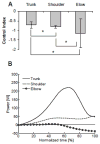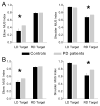Control of human limb movements: the leading joint hypothesis and its practical applications
- PMID: 20871237
- PMCID: PMC2965031
- DOI: 10.1097/JES.0b013e3181f45194
Control of human limb movements: the leading joint hypothesis and its practical applications
Abstract
The leading joint hypothesis (LJH) offers a novel interpretation of control of human movements that involve multiple joints. The LJH makes control of each multijoint movement transparent. This review highlights effective applications of the LJH to learning of new motor skills and to analysis of movement changes caused by aging and motor disorders.
Figures




References
-
- Berthier NE, Clifton RK, McCall DD, Robin DJ. Proximodistal structure of early reaching in human infants. Exp Brain Res. 1999;127(3):259–69. - PubMed
-
- Bhat AN, Galloway JC. Toy-oriented changes in early arm movements III: constraints on joint kinematics. Infant Behav Dev. 2007;30(3):515–22. - PubMed
-
- Conditt MA, Gandolfo F, Mussa-Ivaldi FA. The motor system does not learn the dynamics of the arm by rote memorization of past experience. J Neurophysiol. 1997;78(1):554–60. - PubMed
-
- Dounskaia N. The internal model and the leading joint hypothesis: implications for control of multi-joint movements. Exp Brain Res. 2005;166(1):1–16. - PubMed
-
- Dounskaia N, Ketcham CJ, Leis BC, Stelmach GE. Disruptions in joint control during drawing arm movements in Parkinson’s disease. Exp Brain Res. 2005;164(3):311–22. - PubMed
Publication types
MeSH terms
Grants and funding
LinkOut - more resources
Full Text Sources

